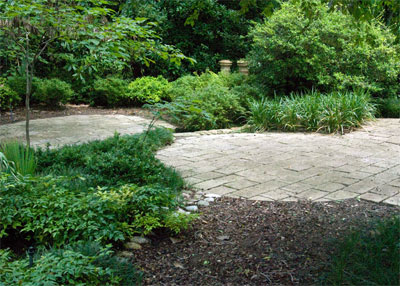From the Sperry Gardens – July, 2010

When we moved to the country in 1978, our sons were 7 and 4. This was an area that got about 7 hours of direct sunlight daily, and it was where we played football on my St. Augustine turf. Over the years, the sun lost track of this space, and the grass migrated out. I finally tired of the battle and decided to turn bare soil into landscaping.
Here are some of the steps in the evolution.
• Split the ground into two levels, so that a round patio could be made on each.
• Made concrete stones over a several-week process with reusable wooden frames. They are 10×10 and 10×16 inches. We sprinkled rock salt onto the cement as it cured, and we pressed a few interesting leaves into the surface. I used a rock hammer to chip off the edges of the stones, to help them look more aged.
• Laid stones on bed of packed brick sand, taking care that they were level.
• Found center of each patio, and used a string and chalk box to mark the perimeter of each circle.
• Used masonry blades (10 or 12) to cut the circles with a circular power hand saw.
• Developed beds around each patio, elevating the planting levels slightly above the patio surfaces to give a bowl-like look to the area.
Plantings you see are, clockwise from lower left:
Harbour Dwarf nandinas
Redbud tree
Dwarf yaupon hollies behind rear patio
Chinese photinias as backdrop to garden for privacy from neighbors
Tree-form yaupon holly to right of two antique English chimney pots
Liriope in front of yaupon tree
Mondograss lower right as groundcover.
You also see a stone retaining wall separating the patios, and river rock used as an edging border at bottom of photo. Garden path is pine bark mulch, which is topped with fresh bark once per year.

